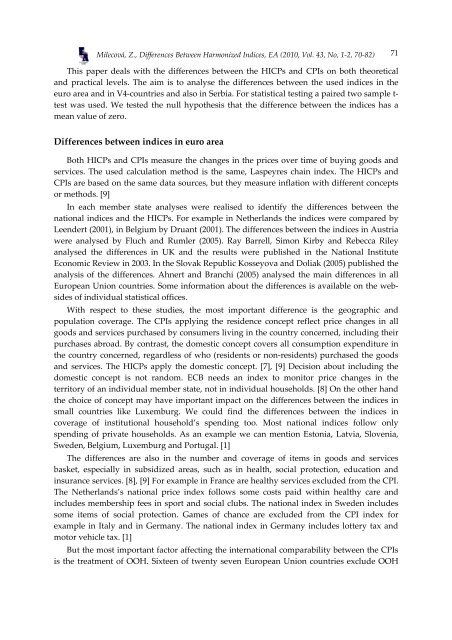Twice a Year Scientific Journal
Twice a Year Scientific Journal
Twice a Year Scientific Journal
You also want an ePaper? Increase the reach of your titles
YUMPU automatically turns print PDFs into web optimized ePapers that Google loves.
Milecová, Z., Differences Between Harmonized Indices, EA (2010, Vol. 43, No, 1-2, 70-82) 71<br />
This paper deals with the differences between the HICPs and CPIs on both theoretical<br />
and practical levels. The aim is to analyse the differences between the used indices in the<br />
euro area and in V4-countries and also in Serbia. For statistical testing a paired two sample t-<br />
test was used. We tested the null hypothesis that the difference between the indices has a<br />
mean value of zero.<br />
Differences between indices in euro area<br />
Both HICPs and CPIs measure the changes in the prices over time of buying goods and<br />
services. The used calculation method is the same, Laspeyres chain index. The HICPs and<br />
CPIs are based on the same data sources, but they measure inflation with different concepts<br />
or methods. [9]<br />
In each member state analyses were realised to identify the differences between the<br />
national indices and the HICPs. For example in Netherlands the indices were compared by<br />
Leendert (2001), in Belgium by Druant (2001). The differences between the indices in Austria<br />
were analysed by Fluch and Rumler (2005). Ray Barrell, Simon Kirby and Rebecca Riley<br />
analysed the differences in UK and the results were published in the National Institute<br />
Economic Review in 2003. In the Slovak Republic Kosseyova and Doliak (2005) published the<br />
analysis of the differences. Ahnert and Branchi (2005) analysed the main differences in all<br />
European Union countries. Some information about the differences is available on the websides<br />
of individual statistical offices.<br />
With respect to these studies, the most important difference is the geographic and<br />
population coverage. The CPIs applying the residence concept reflect price changes in all<br />
goods and services purchased by consumers living in the country concerned, including their<br />
purchases abroad. By contrast, the domestic concept covers all consumption expenditure in<br />
the country concerned, regardless of who (residents or non-residents) purchased the goods<br />
and services. The HICPs apply the domestic concept. [7], [9] Decision about including the<br />
domestic concept is not random. ECB needs an index to monitor price changes in the<br />
territory of an individual member state, not in individual households. [8] On the other hand<br />
the choice of concept may have important impact on the differences between the indices in<br />
small countries like Luxemburg. We could find the differences between the indices in<br />
coverage of institutional household’s spending too. Most national indices follow only<br />
spending of private households. As an example we can mention Estonia, Latvia, Slovenia,<br />
Sweden, Belgium, Luxemburg and Portugal. [1]<br />
The differences are also in the number and coverage of items in goods and services<br />
basket, especially in subsidized areas, such as in health, social protection, education and<br />
insurance services. [8], [9] For example in France are healthy services excluded from the CPI.<br />
The Netherlands’s national price index follows some costs paid within healthy care and<br />
includes membership fees in sport and social clubs. The national index in Sweden includes<br />
some items of social protection. Games of chance are excluded from the CPI index for<br />
example in Italy and in Germany. The national index in Germany includes lottery tax and<br />
motor vehicle tax. [1]<br />
But the most important factor affecting the international comparability between the CPIs<br />
is the treatment of OOH. Sixteen of twenty seven European Union countries exclude OOH
















